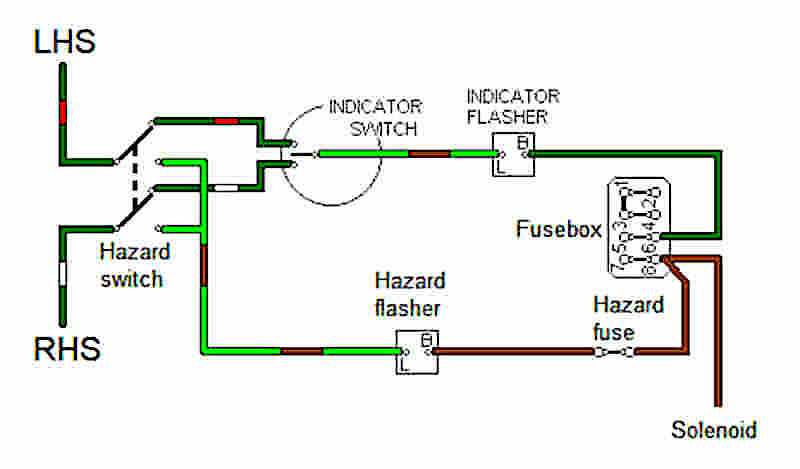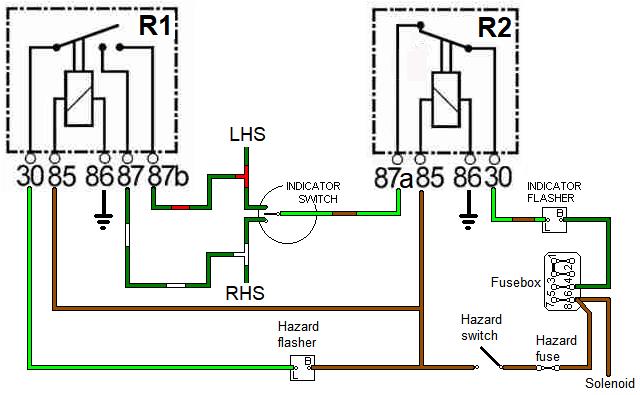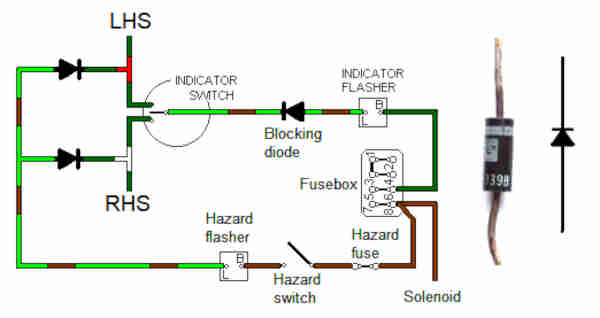Adding hazards to earlier cars
Hover over a wire to confirm the colour
With the hazard switch off the light-green/brown, green/white, green/red and light-green/purple (where provided) are all isolated from one another, and the two greens (one from the fusebox and the other to the indicator flasher) are connected together.
When the hazard switch is on the two greens are isolated from each other, and the other four are all connected together. The load of the four indicator bulbs starts the hazard flasher flashing on and off after a short delay.
Note 1: Tin-dash cars seem to have a local earth from the physical mounting of the bulb-holder in the bracket. American padded-dash, all V8s and rubber bumper cars have a wired earth to the bulb holder as they are mounted in plastic panels.
Note 2: Originally the fuse - like the flasher unit, was behind the console and hence inaccessible. At some point it moved to under the fusebox - possibly with rubber bumpers although the V8 remained behind the console, possibly with 1977 models. At the same time the flasher unit moved to behind the dash by the indicator flasher.
Note 3: Rubber bumper cars have a single orange lensed light unit in the bumper with a wired earth to the main harness with the headlamp earth. RHD cars have a single filament bulb which is for the indicators/hazards only, North American spec have a dual filament bulb for the parking lights as well as the indicators/hazards.
Hazard warning repeater (light-green/purple) on North American spec only.
For the 1977 model year on the switch was illuminated when the hazards were on.
Options for adding hazard flashers to earlier cars:

Requires breaking into the white/red and white/green wires, which can be done at the bullet connectors between the main and rear harnesses in the engine bay if you don't want to cut wires.
Using a dedicated hazard fuse from the brown circuit (always live unfused) is preferable to using the purple circuit which is already fused in the fusebox. This is because the purple wire goes across the front of the car and could have been damaged in a frontal impact so blowing that fuse.

These relays are different to the starter and ignition relays usually found on an MGB. Both relays operate when the hazard switch is turned on. R1 is a 'dual make' (aka double make, twin make) relay which connects the input 30 to two separate output contacts 87 and 87b when the relay is operated, connecting the hazard flasher unit to the lamp wires. When the relay is released the two outputs are isolated from one another, not to be confused with high power relays with one or two 87 terminals but no 87b terminal. R2 is a 'normally closed' relay with an 87a terminal, disconnected from terminal 30 when the relay operates, isolating the indicator flasher unit if the indicator switch has been left operated.

Avoids cutting into wires but three diodes have to be used, suggested 5 amp, 60v minimum such as SR506. The blocking diode can be connected at the indicator flasher spade terminal. The white band on the diode represents the point of the arrow in the symbol, orientation shown above is for negative earth cars, they would need to be reversed for positive earth. On the right is shown how a typical physical diode relates to the circuit diagram symbol. Using diodes is not ideal as they always exhibit a forward volt-drop which reduces the voltage at the load, in this case lamps which will reduce their brightness slightly. Proponents of electronic ignition should note that the same effect reduces current through the ignition coil compared to a decent set of points!